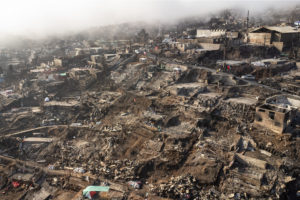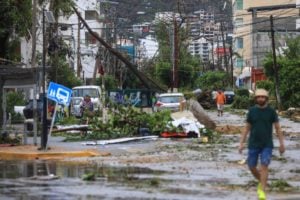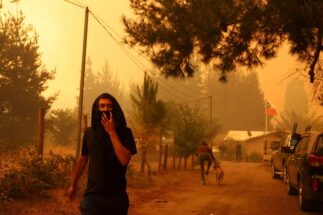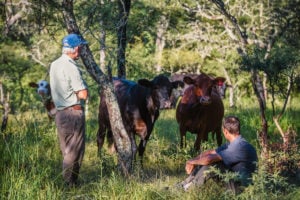Multiple forest fires have struck central and southern Chile in recent weeks, with those in the Valparaíso region being the deadliest in the country’s recent history. As of 11 February, at least 131 people had died as a result of the wildfires, with more than 300 said to be missing, and over 40,000 people affected.
Chilean president Gabriel Boric said the forest fires were “the biggest tragedy” the country has faced since the 2010 earthquake, which left 525 dead and affected around two million people. While the fires in the Valparaíso region have now been largely contained, the reconstruction work will be complex, with 20,000 tonnes of debris already removed.
Diálogo Chino spoke with Miguel Castillo, a professor at the University of Chile’s Forest Fire Laboratory, to hear more on the main causes behind the fires. Castillo said multiple factors contributed to the tragedy, including issues beyond forestry, and that a comprehensive plan is required from the government to address recovery and the prevention of future disasters.
Responses to the alert
In emergency situations, Chileans receive an alert on their phones through the Emergency Alert System (SAE), managed by the National Disaster Prevention and Response Service (Senapred), a government entity. This warning system is built into all mobile devices and issues notifications to users to evacuate.
President Boric said the alerts were sent out, but that evacuation was difficult given the speed at which the fires were spreading, in some areas at more than 10 kilometres per hour – faster than most people can walk, he noted. Some victims said they had not received the alert, prompting Boric to call for an investigation into the system’s functioning.
In Chile, we have a culture around earthquakes, floods and drought. But we don’t have a culture for fires.Miguel Castillo, professor at the University of Chile’s Forest Fire Laboratory
Castillo said that while the alert largely worked, it did not tell people where to flee to. “The SAE alert must be accompanied by preventive education on how to act,” he said. “In Chile, we have a culture around earthquakes, a culture around floods and a culture around drought. But we don’t have a culture for such fires.”
Many people in Valparaíso also decided to stay at home and not follow the evacuation instructions issued in the alert “in the hope that the fire will not reach them, and also to protect their property” from theft, Castillo added. But he said this decision creates the greatest difficulties for people, because “when they want to escape, they can’t.”
Urban planning
In the most affected region, Valparaíso, infrastructure is another factor explaining the scale of the fires. Some of the burned areas are densely populated, with their expansion having often taken place without planning permission. Additionally, many houses there are informal dwellings that may have been constructed with flammable materials such as wood.
The population in the Valparaíso area has increased significantly in the last two years, Castillo said, and hilly areas impacted by the fires had been recently occupied: “The fire engines couldn’t get in to put out the fires because of a lack of roads [in the newly inhabited areas], or because they got stuck on narrow ones.” These newer houses were also built using wood, he noted.
Moreover, Castillo explained, some precarious buildings in the burned areas were located in places where there were originally firebreaks – gaps of land without any material or vegetation that can burn, which prevent the spread of fires. “The municipalities were warned of the risk. But once houses are installed, it is difficult to remove them,” he added.
The Minister of Social Development and Family, Javiera Toro, said that the reconstruction of the houses will take “a couple of years”. In Castillo’s opinion, to rebuild the area as it was “would be irresponsible” because of the continued risk of fire in the area. He said this is an opportunity to reduce that risk through better urban planning.
Climatic factors
A 2020 study by the Centre for Climate and Resilience Research (CR2) found that since 2010 forest fires in south-central Chile have increased in terms of occurrences and area burned, compared to the previous three decades, while the average duration of the fire season has also become longer.
In the first days of February, when the fires broke out, South America was experiencing a heatwave that drove temperatures in the Valparaíso region up to 33C. At the same time, the region recorded wind gusts of up to 60 kilometres per hour, which enabled the flames to spread rapidly.
Since 2010, Chile has suffered from a mega-drought driven by human and climatic factors – but in 2023, it experienced more rainfall than usual. This allowed for the regeneration of grasses and shrubs, which ignite rapidly in a fire, Castillo explained: “That vegetation added to the fuel load from other years that had not burned.”
Since the 1960s, the average temperature in Chile has increased by an average of 0.13C per decade. CR2’s study estimated that this gradual rise in temperature, driven by climate change, contributed to 20% of the total area burned between 1985 and 2016 in south-central Chile. Climate projections are not encouraging, the study argues, which could increase the risk of fires.
Invasive species
Over the last 40 years, the fire-affected south-central zone of Chile has been transformed by vast forest plantations of exotic species, especially pine and eucalyptus, introduced for timber and pulp production. In fact, the area now has more hectares of forest plantations than native forests.
CR2 highlighted in the report that exotic plants can modify the dynamics of forest fires, increasing the speed of spread, as well as their extent, frequency, intensity and seasonality. Some 70% of exotic plants in Chile come from regions where forest fires occur frequently, such as North America and Australia.
“In a climate change scenario where temperature and humidity conditions will increase the frequency, extent and intensity of wildfires, the spread of exotic vegetation may exacerbate the impacts of wildfires on natural ecosystems and human well-being, increasing the risk of wildfires,” argued CR2.
Castillo noted that forestry companies have increased their investment in fire prevention projects, but still have a public image problem. During the fires, Boric raised the need for better regulation of the industry, but the forestry trade association criticised his view and insisted that without their prevention work, the situation would be “more complex”.
Questions over intentional fires
At least some of the recent fires may have been intentionally started, claimed Minister of the Interior and Public Security Carolina Tohá. President Boric said that if those responsible for fires are identified, “they will be sought and found, and will have to face the repudiation of society and the weight of the law.”
According to the CR2 study, fires in Chile are mainly caused by humans, either accidentally or by deliberate action. The occurrence and risk of fires is linked to the proximity of urban centres and infrastructure, such as roads, recreational sites and railway lines.
Of the total number of fires recorded between 1985 and 2018, it was only possible to determine the cause of 89% of them, CR2 reported. Of these, 56% were accidental, with 32% intentional, 11% having no known cause and less than 1% being natural, the latter mainly caused by lightning. In the south-central zone, which has been most affected by fires in the country, accidental causes were the most frequent.
Intentional fires present challenges for safety and prevention, said Castillo, who noted that the prevention systems had a significant increase in their budget. “They were modernised and Chile is now a regional benchmark,” he said. “But what has been gained in modernity goes down the drain with intentionality. You can have very prepared people for the first response, but a group can set a fire.”










